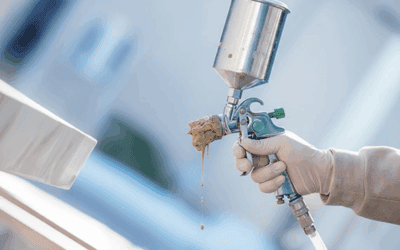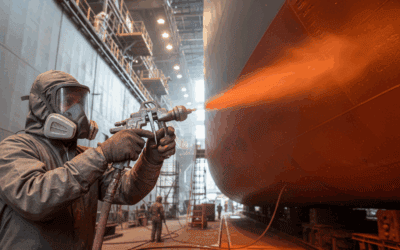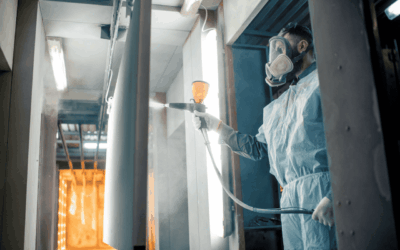Understanding atomisation in spray painting: What it is and why it matters
At the heart of every successful spray painting job lies a fundamental process: atomisation.
This is the technique by which liquid paint is broken down into a fine mist of tiny droplets before being applied to a surface. Proper atomisation ensures even coverage, strong adhesion, and a smooth, professional-grade finish.
Whether you're using airless, air-assisted, HVLP or conventional spray systems, understanding the science behind atomisation can significantly improve your results. This blog breaks down the basics, the common issues, and practical tips to optimise your spray setup.
Why does atomisation matter?
Good atomisation plays a direct role in determining the finish quality, durability, and efficiency of a paint job. Poor spray mist formation can result in several familiar problems:
- Orange peel: Caused by large, uneven droplets that fail to level out.
- Overspray: Uncontrolled droplets land outside the intended area.
- Runs and sags: From excessive paint delivery in one spot.
- Low transfer efficiency: More paint ends up in the air than on the surface.
Effective paint droplet control improves transfer efficiency, reduces waste, and ensures the coating behaves as expected during application and drying.
The science behind spray atomisation
Atomisation occurs when high-velocity air (in air spray systems) or high fluid pressure (in airless systems) disrupts the surface tension of paint, causing it to break into droplets. The smaller and more uniform the droplets, the smoother and more consistent the finish.
In technical terms, atomisation quality is often measured using:
- Sauter mean diameter (SMD): A way to describe the average droplet size relative to surface area.
- Volume median diameter (VMD): The droplet size where half the volume of paint is in smaller droplets, and half is in larger.
Smaller SMD/VMD values generally mean better atomisation and a finer finish.
Types of atomisers and their effects
Different spray systems achieve atomisation in different ways:
- Airless sprayers use high fluid pressure to force paint through a small nozzle, breaking it into droplets without air assistance.
- HVLP (high volume, low pressure) sprayers rely on high air volume at low pressure, producing a softer spray with reduced overspray.
- Conventional air spray systems use compressed air to atomise the fluid, producing fine droplets but potentially more overspray.
- Rotary bell atomisers mechanically spin paint at high speeds (up to 60,000 rpm), flinging it into a fine mist. These are often paired with electrostatic charging for high transfer efficiency in industrial applications.
You can also distinguish between:
- Internal-mix nozzles: Air and paint mix inside the gun; suited for thicker materials or hard-to-atomise fluids.
- External-mix nozzles: Mixing happens outside the tip; better for achieving finer finishes with thinner materials.
Explore our spray systems and equipment here.
Factors that influence atomisation
Several key factors affect atomisation quality:
- Nozzle size and type: Smaller nozzles create finer droplets but may clog with thicker materials. Tip selection should match your coating.
- Paint viscosity: Thicker paints require more pressure or larger nozzles to atomise effectively.
- Air or fluid pressure: In air-assisted systems, increasing pressure can improve atomisation, but too much causes overspray.
- Spray distance and angle: Holding the gun too close or too far can disrupt the spray pattern and cause uneven coating.
- Electrostatic charge: Adding electrostatics improves droplet attraction to the surface and boosts transfer efficiency.
How to optimise your spray technique
Fine-tuning your setup can drastically improve your atomisation results. Here are some proven methods:
- Choose the right equipment: Match your spray gun, nozzle, and pressure settings to the paint type and surface. Use manufacturer charts when selecting tips and pressure.
- Test before each job: Spray onto cardboard or scrap material to assess droplet size, pattern consistency, and atomisation.
- Calibrate pressure settings methodically: For HVLP: Start with a low pressure (air cap pressure ~10 psi), increase atomising air in small increments (3-5 psi), then adjust fluid pressure for coverage.
- Maintain your equipment: Worn or blocked nozzles disrupt atomisation. Clean guns regularly and replace components as needed. Tungsten carbide or stainless steel nozzles offer greater durability.
- Control your environment: Temperature, humidity, and airflow impact paint behaviour. Aim for stable conditions and avoid draughty spaces that affect mist pattern.
Conclusion
Understanding atomisation is the core of effective spray painting. By understanding the mechanics behind it and learning how to optimise your system, you can prevent costly defects, reduce waste, and achieve professional, repeatable results.
Want to learn more about spray painting techniques and equipment setup?
Explore our resources or get in touch with our technical team for expert advice.



